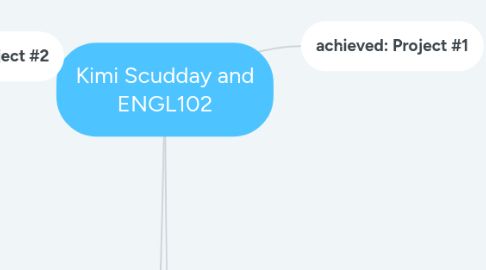
1. Topic Sentence: Throughout this English 102 class, I have achieved a lot of things but also struggled with some things too.
2. struggled: Project #2
2.1. DD9: annotate and analyze your articles
2.1.1. SLOs: 1.B, 2.A, 2.D, 2.F, 3.D, 3.F, 4.B, 4.C
3. achieved: Project #2
3.1. DD10HW5: draft your comparative rhetorical analysis
3.1.1. SLOs: 1.B, 1.E, 2.A, 2.B, 2.D, 2.F, 3.A, 4.B, 4.C, 4.D
3.1.1.1. 1.B: analyze the ways a text’s purposes, audiences, and contexts influence rhetorical options
3.1.1.2. 1.E: respond to a variety of writing contexts calling for purposeful shifts in structure, medium, design, level of formality, tone, and/or voice
3.1.1.3. 2.A: employ a variety of research methods, including primary and/or secondary research, for purposes of inquiry
3.1.1.4. 2.B: evaluate the quality, appropriateness, and credibility of sources
3.1.1.5. 2.D: synthesize research findings in development of an argument
3.1.1.6. 2.F: compose persuasive researched argument for various audiences and purposes, and in multiple modalities
3.1.1.7. 3.A: adopt composing in revision processes for variety of technologies and modalities
3.1.1.8. 4.B: reflect on why genre conventions for structure, paragraphing, tone, and mechanics vary
3.1.1.9. 4.C: identify and effectively use variations in genre conventions, including formats and/or design features
3.1.1.10. 4.D: demonstrate familiarity with the concepts of intellectual property (such as fair use and copyright) that motivate documentation conventions
3.2. DD12HW1T4: submit final, polished version of P#2 comparative rhetorical analysis
3.2.1. SLOs: 1.B, 1.E, 2.A, 2.D, 2.F, 3.A, 4.B, 4.C, 4.D
4. achieved: Project #1
4.1. DD4HW1: conduct research
4.1.1. SLOs: 2.A, 2.B
4.1.1.1. 2.A: employ a variety of research methods, including primary and/or secondary research, for purposes of inquiry
4.1.1.2. 2.B: evaluate the quality, appropriateness, and credibility of sources
4.2. DD7HW3: submit final, polished version P#1 Annotated Bibliography
4.2.1. SLOs: 1.B, 2.A, 2.B, 2.D, 3.A, 4.C, 4.D
4.2.1.1. 1.B: analyze the ways a text’s purposes, audiences, and contexts influence rhetorical options
4.2.1.2. 2.A: employ a variety of research methods, including primary and/or secondary research, for purposes of inquiry
4.2.1.3. 2.B: evaluate the quality, appropriateness, and credibility of sources
4.2.1.4. 2.D: synthesize research findings in development of an argument
4.2.1.5. 3.A: adopt composing in revision processes for variety of technologies and modalities
4.2.1.6. 4.C: identify and effectively use variations in genre conventions, including formats and/or design features
4.2.1.7. 4.D: demonstrate familiarity with the concepts of intellectual property (such as fair use and copyright) that motivate documentation conventions

